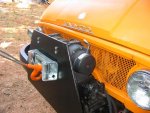Your winch already dictated which cable you "must" use. The direction that the drum spools in, and which side of the drum the first layer start on dictate that you should continue using the specified cable, which without looking it up I believe is a right hand lay. If it's not specified anywhere then you can be pretty sure it's a right hand lay.
How bad are the reprocussions? We're not talking about cranes and elevators here. Look at any light or light medium (and even a few heavy medium) conventional tow truck you see. Each time you find one with a winch mounted on either side of the boom.... One cable should be left hand lay, but isn't. If a cable is wrong for the winch, keep a little closer eye on how it wraps until it's "trained" well, and it's a non-issue.
If you find left hand cable, see what it's worth... Very few people use it, and when they do it's very specialized usage. It's either increadibly expensive or increadibly cheap... If it's cheap, well, I'll just say that it doesn't make me cry any to reverse which winch has the correct lay and which winch has the incorrect lay.
That said, you do have to be a little bit careful. Clamps, clips, and general repair accessories are few and far between. If you're making your own cables, you may find that you are teaching yourself to splice the rope. Non directional items such as smooth sheaves, thimbles, and such work either way. Other items, for example cable clips, and I BELIEVE the clevis terminations on military winches have the rope's shape cast into the saddle. These absolutely and without fail need to be correct for whichever rope you're working with.
Splicing is not so bad BTW after you get good at it, and properly done it will yield the strongest possible results. I am not good at it and I still have to read the cheat sheets... The fellow who first showed me how to do it, if all his tools are already out, can splice in a beautiful factory looking thimble termination almost as fast as I can get three cable clips bolted on.
 ).
).



